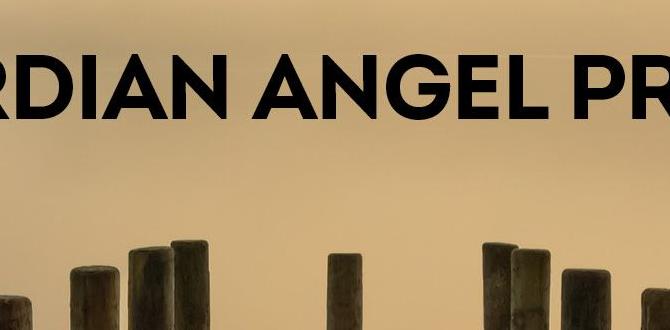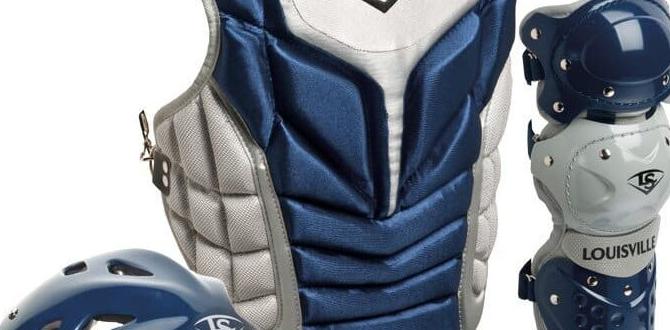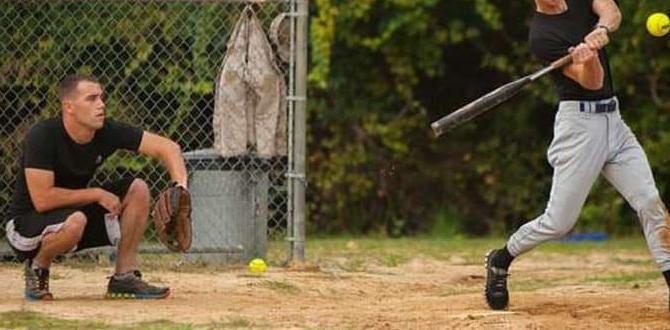Quick Summary: Louisville Slugger makes great catchers shin guards for players. They’re different from umpire gear, focusing on player impact protection, not just visibility. Choosing the right set means prioritizing safety and game performance to protect your legs during every play at the plate. We’ll help you understand the key differences.
Hey everyone, John P. Miller here from FriskMode! Ever stood behind the plate, that knot of anxiety in your stomach, wondering if your legs are truly ready for those searing fastballs or aggressive slides? It’s a common feeling, especially for those stepping into the catcher’s shoes or even umpiring a game. The gear can look similar, but knowing what you need for catching versus officiating is super important. We’re going to break down Louisville Slugger catchers shin guards and how they stack up against umpire gear. You’ll learn exactly what makes them tick and how to pick the perfect pair for safety and confidence. Let’s get your game protected!
Louisville Slugger Catchers Shin Guards: What Makes Them Special?
When you’re behind the plate, your shin guards are your first line of defense against wild pitches, foul balls, and collisions. Louisville Slugger, a name synonymous with quality baseball equipment, offers shin guards designed with the catcher’s specific needs in mind. These aren’t just random pieces of plastic; they’re engineered for mobility, protection, and comfort, allowing you to move freely and focus on the game.
The primary goal of catcher’s shin guards is to shield the catcher’s lower legs and feet from impact. This includes:
- Direct impacts from pitches: Whether it’s a splitter that drops or a fastball that gets away, your shins take a beating.
- Foul tips off the bat: These can sting and cause serious injury if not properly protected.
- Collisions at the plate: Runners sliding in can sometimes make contact with a catcher’s legs.
- General wear and tear: The constant squatting and moving requires gear that can withstand the demands of the position.
Louisville Slugger’s approach to catcher’s shin guards focuses on a few key areas: robust protection, flexible design for movement, and a secure fit. They understand that a catcher needs to be agile, able to block pitches, transfer the ball quickly, and be ready for the next play without feeling weighed down. This means the materials, padding, and articulation are all carefully considered.
Understanding the Core Design of Catcher’s Shin Guards
Catcher’s shin guards typically feature a multi-piece construction. This allows for better flexibility and a more anatomical fit. You’ll often find:
- Hard outer shell: Usually made of durable plastic or composite materials designed to absorb and deflect impact.
- Thick padding: Layers of foam, often EVA (ethylene-vinyl acetate) or memory foam, provide cushioning against shock.
- Straps and buckles: Adjustable straps ensure a snug and secure fit, preventing the guards from shifting during play. This is crucial for consistent protection.
- Shin and knee cap coverage: The design aims to cover the entire shin bone and provide ample protection for the knee joint, including the patella.
- Ankle and foot protection: Many models incorporate elements that protect the ankle and the top of the foot.
Louisville Slugger invests in research and development to ensure their shin guards meet the rigorous demands of the catcher position. They often use proprietary padding technologies and ventilation systems to keep players comfortable during long games and practices. The goal is to provide maximum protection without compromising a catcher’s ability to perform their duties effectively.
What is Umpire Gear and How Does It Differ?
Now, let’s talk about umpire gear. While it also protects the lower body, its purpose and design are fundamentally different because the umpire’s role is distinct from a player’s. Umpires need protection, but they also have different priorities: visibility, freedom of movement for calling plays, and durability for frequent use.
The most noticeable difference is often the color. Umpire gear is frequently black or dark navy to blend in with the uniform and avoid distracting players or fans. While some catcher’s gear comes in the same colors, the emphasis is less striking. Umpire shin guards, sometimes called leg guards, are designed with several distinct features:
- Visibility and Discretion: Their primary function isn’t to absorb the extreme force of a direct pitch or a collision, but to offer a baseline of protection while being unobtrusive.
- Lightweight Construction: Umpires are on their feet all game, constantly moving. Lighter leg guards reduce fatigue.
- Full Leg Coverage: Umpires need protection from the knee down to the toe, often with integrated shin, knee, and foot guards.
- Sturdy Strapping: Secure straps are essential for keeping the guards in place without constant adjustment, allowing them to focus on the game action.
- Durability Over Extreme Impact Resistance: While they need to be tough, they aren’t typically built to withstand the punishing, repeated impacts that a catcher experiences.
Umpire shin guards often have a more streamlined profile. They aim to provide a protective shell and some padding, but the focus isn’t on cushioning for high-velocity impact as much as it is on abrasion resistance and stopping stray balls from hitting the leg directly. They need to be flexible enough for an umpire to crouch, stand, and move to get the best view of the play.
Key Differences at a Glance: Catcher vs. Umpire Shin Guards
To make it crystal clear, let’s look at the main distinctions between Louisville Slugger catcher shin guards and typical umpire gear:
| Feature | Louisville Slugger Catchers Shin Guards | Umpire Shin Guards |
|---|---|---|
| Primary Function | Maximum impact absorption from pitches, foul tips, and collisions. | General protection from stray balls, abrasion, and minor impacts; discreet visibility. |
| Padding | Thick, dense padding designed for shock absorption and comfort during prolonged squatting. | Lighter padding, focused on comfort and basic protection rather than extreme shock absorption. |
| Shell Material & Design | Often multi-component, articulated for flexibility. Hard shell designed to withstand significant force. | Typically a more rigid shell for protection, but less emphasis on flex for extreme impact. |
| Coverage | Extensive coverage of shin, knee, and often knee-cap/thigh area. Foot protection is common. | Full shin, knee, and foot coverage. Design prioritizes a streamlined fit. |
| Mobility Focus | Engineered for a catcher’s specific stances and movements (squatting, blocking, quick transfers). | Designed for general movement, standing, and crouching for optimal viewing angles. |
| Appearance | Can come in various colors. Design emphasizes protection and function. | Usually dark colors (black, navy) for discretion with uniform. |
It’s important to remember that while both are protective gear, they are built for different scenarios. Using umpire gear as a catcher would leave you vulnerable to serious injury. Conversely, catcher’s gear might be a bit too bulky for an umpire who needs to move swiftly and unobtrusively.
Why Choose Louisville Slugger for Catcher’s Shin Guards?
Louisville Slugger has a long history of supporting baseball players at all levels. Their commitment to quality means you’re investing in gear that is:
- Durable: Built to withstand the rigors of a full season, game after game.
- Protective: Designed with advanced padding and shell technology to offer superior impact resistance.
- Comfortable: Thoughtfully designed for a snug fit that doesn’t hinder movement or cause irritation. Many models feature breathable linings and ergonomic shapes.
- Performance-Oriented: Louisville Slugger understands the catcher’s need for agility. Their shin guards allow for a full range of motion, from blocking pitches to throwing runners out.
When you see the Louisville Slugger name on shin guards, you can be confident in the engineering and thought that went into their creation. They are a trusted brand for a reason. You can find detailed specifications and often customer reviews on their official product pages or through reputable sporting goods retailers.
Fit and Sizing: Getting it Right for Optimal Protection
No matter the brand, proper fit is paramount for both catcher and umpire shin guards. For Louisville Slugger catchers shin guards, you’ll want to measure. Often, sizing is based on the length from the middle of the kneecap to the ankle bone, or sometimes the total length of the guard. Here’s a general idea of what to look for when fitting catcher’s shin guards:
- Measure Accurately: Have someone help you measure from the center of your kneecap straight down to your ankle bone while you’re in a squatting position. Also, measure from the top of your shoe to your kneecap.
- Check for Coverage: When trying them on, ensure the kneecap protector fully covers your kneecap. The bottom should extend to cover your ankle and the top of your foot area effectively.
- Secure Fit: Fasten all straps. The shin guards should feel snug but not constricting. They shouldn’t slide down your leg when you move, nor should they pinch.
- Comfort in Stance: Get into a catcher’s squat. Can you hold the position comfortably? Do the guards dig into your shins or knees? Are they too stiff, hindering ankle flex?
- Mobility Test: Stand up, squat down, take a few steps. The guards should move with your legs, not against them.
For umpires, the fit is similar in terms of securing the gear comfortably and ensuring it doesn’t impede movement. However, the emphasis might be more on ensuring they lay flat and don’t add unnecessary bulk that could obstruct calls.
Essential Features to Look for in Louisville Slugger Catchers Shin Guards
When browsing Louisville Slugger’s line of catcher’s shin guards, here are some features that distinguish excellent models:
- Articulated Knee/Cap Design: This allows the knee and shin pieces to move independently, offering better flexibility and protection when squatting and blocking.
- Ventilation System: Look for shin guards with vents or breathable materials to help keep your legs cooler and drier during intense play.
- Removable/Washable Liners: These are a huge plus for hygiene and keeping your gear fresh.
- Strategic Padding: Some models have reinforced padding in high-impact zones for added protection.
- Durable Buckle and Strap Systems: Robust straps and buckles ensure the guards stay put, even through aggressive play.
- Toe Protection: Integrated toe guards provide an extra layer of defense against foul balls or dropped bats.
Louisville Slugger often offers different series or models within their catcher’s gear line, catering to various age groups and skill levels. For instance, youth models will be sized appropriately and may have slightly less robust padding than elite adult models, but still offer excellent protection for their intended use. Always check the product descriptions to understand the specific features of the model you’re considering.
Louisville Slugger’s Commitment to Youth Players
It’s not just about adult leagues. Louisville Slugger also provides excellent catcher’s shin guards for youth players. These are designed with the same principles of protection and mobility but scaled for younger athletes. They often feature:
- Lighter materials for easier wear.
- Adjustable straps that grow with the child.
- Reduced bulk while maintaining critical coverage.
- Bright, appealing colors that kids love.
Ensuring young catchers have the right fit and protection is crucial for their development and safety. It builds confidence and encourages them to embrace the challenging and rewarding position.
Umpire Gear: Priorities for Officiating
If you’re an umpire, or looking to become one, shin guards are a must-have. They offer a layer of protection that’s vital when you’re right in the middle of the action. Umpire leg guards are designed with:
- Mobility for Calling Balls and Strikes: Umpires need to be able to get into a good position quickly and hold it to see pitches clearly, especially in youth leagues where the strike zone can be less consistent. Flexibility in the knee and shin allows for this.
- Durability for Frequent Use: Umpires officiate many games, often back-to-back. The gear needs to be tough and hold up to the demands of constant movement and varied weather conditions.
- Protection from Accidental Impacts: While not designed for direct, high-speed impacts like catcher’s gear, they protect against foul balls that might miss the catcher or accidental contact with players.
- Comfort over Long Periods: Umpires spend entire games on their feet. Comfort is key to maintaining focus and performance.
When selecting umpire gear, look for models that offer a balance of protection, comfort, and adjustability. Many brands offer umpire leg guards, and while Louisville Slugger might be known for player equipment, there are specialized umpire gear manufacturers that excel in this niche. It’s always a good idea to check resources for umpires, such as the Umpire Gear website, for recommendations specific to the officiating community.
The Importance of Proper Stance and Movement for Umpires
A good umpire’s stance is crucial for accurate calls. This involves bending the knees and hips to get low, often parallel to the catcher. Protective leg gear needs to facilitate this without being cumbersome. The shin guards should allow for:
- Deep Squatting: Ability to get low without the gear restricting thigh or calf movement.
- Side-to-Side Movement: Maneuvering to get the best angle on plays at the plate or along the base lines.
- Quick Standing: Rising up to call plays or react to batted balls.
The padding in umpire gear is typically less dense than catcher’s gear, prioritizing freedom of movement and less bulk. This ensures the umpire remains nimble and focused on observing the game.
When Might Catcher’s Shin Guards Be Used Casually?
While we’ve clearly established the difference, you might wonder if there are any overlaps or casual uses. Generally, no. Catcher’s shin guards are purpose-built for one job: catching. Using them for anything else is usually impractical, and vice versa.
However, some specialized training drills might involve modified gear, but this is rare and usually involves custom setups approved by coaches. For standard play or umpiring, sticking to the gear designated for your role is always the safest and most effective approach. The protective qualities of Louisville Slugger catcher’s shin guards are specifically tuned for the impacts a catcher faces. Attempting to use them in a different capacity wouldn’t leverage their strengths and could even hinder performance.
FAQ: Your Top Questions Answered
Q1: Can I use umpire shin guards for playing catcher?
A1: No, it’s strongly advised not to. Umpire shin guards offer basic protection, but they lack the dense padding and robust impact absorption needed to protect a catcher from direct pitches, foul tips, and collisions. This can lead to serious injury.
Q2: Are Louisville Slugger catcher’s shin guards worth the investment?
A2: Yes, for dedicated catchers, Louisville Slugger shin guards are a worthwhile investment. They offer excellent protection, durability, and comfort, which are all crucial for a developing or seasoned catcher. They are built to last and perform.
Q3: How do Louisville Slugger shin guards help catchers with mobility?
A3: Louisville Slugger designs their catcher’s shin guards with articulated pieces and flexible materials. This allows the knee and shin components to move independently, providing protection without restricting the catcher’s ability to squat, block, and transition quickly.
Q4: What’s the best way to clean my catcher’s shin guards?
A4: Most shin guards can be cleaned with a damp cloth and mild soap. For removable liners, follow the care instructions, which often allow for hand washing. Always air dry them completely to prevent mildew and odors. Avoid harsh chemicals.
Q5: Do youth catcher’s shin guards offer enough protection?
A5: Well-made youth catcher’s shin guards, like those from Louisville Slugger, are designed to offer appropriate protection for young players. They balance protection with lighter materials and sizing suitable for kids, ensuring they are safe and comfortable.
Q6: Can I use catcher’s shin guards for other sports?
A6: While they offer good leg protection, catcher’s shin guards are specifically shaped and padded for baseball. For other sports like soccer or hockey, specialized gear




